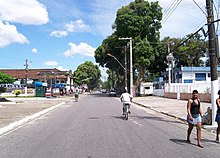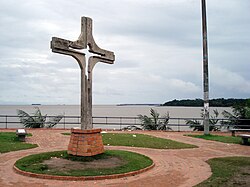|
Icoaraci
Icoaraci is one of the eight districts in which the municipality of Belém, capital of the state of Pará, in Brazil, is divided. It is located approximately 20 km from the center of the state capital and has around 200,000[3] inhabitants, according to the IBGE. It is situated near the Outeiro island, which can be accessed by boat at the port of 7th street or by a bridge. In Icoaraci you can also take daily ferries to Marajó Island and boats to Cotijuba Island, which can only be reached this way.[4][5] The district center comprises the neighborhoods Águas Negras, Agulha, Campina de Icoaraci, Cruzeiro, Maracacuera, Paracuri, Parque Guajará, Xiteua, Recanto Verde, COHAB, Ponta Grossa, Pratinha, and several residential areas. It has a Human Development Index (HDI) lower than many African countries and regions at war, such as Syria, Afghanistan and Iraq. Its original nucleus, from which it expanded, retains the terms travessas (English: lane) and ruas (English: streets), the latter called daily in the order of their foundation: 1st, 2nd, and so on until it reaches 7th street.[6] ToponymIcoaraci is a word of Tupi origin that means "sun of the river", from the junction of y (water, river)[7] and kûarasy (sun).[8] EconomyThe economy of Icoaraci is based on an industrial park that shelters, mainly, the fishing, wood, carpentry, and heart of palm branches. Another economic hub of the district is the open-air market of Oito de Maio, one of the busiest in Belém and the most frequented in Icoaraci, located in the Campina neighborhood. In addition, the district has three large warehouses, the so-called "atacarejos", a mixture of wholesale and retail foodstuffs.[9] However, Icoaraci really stands out as an important ceramic handicraft center, installed in the Paracuri neighborhood, where replicas of typical vessels from ancient indigenous nations, mainly Marajoara and Tapajonic, are produced from pieces catalogued by the Paraense Emílio Goeldi Museum. This art guarantees immeasurable importance to the place, especially cultural, not only for Belém or for Pará, but for the Amazon region, since it is also home to several folkloric groups of typical dances (Asa-Branca, Vaiangá, Balé Folclórico da Amazônia, Grupo de Expressões Culturais Art Marajoara), of musicians (Mestre Verequete, Nazaré Pereira) and of the poet Antônio Tavernard, among other exponents of Amazonian art who still live there, such as Mestre Cardoso (potter) and professor Etelvina (folk dancer), both pioneers in their art.[9] The district has a good electrical and telecommunication structure, besides the structure of services such as banks, hospitals, forum, registry office, supermarkets, several schools, churches, taxi services and ridesharing. Icoaraci remains as an important center where small riverside municipalities and nearby neighborhoods converge. Tourism is strong in Vila Sorriso, with the exhibition of indigenous ceramics in São Sebastião Square, right on the shore bathed by Guajará Bay, where the visitor is well served by a gastronomic pole composed of typical Pará cuisine (tacacá, maniçoba, pato-no-tucupi), with emphasis on the caldeirada with Amazon river fruits that can be found in the restaurants and kiosks surrounding Cruzeiro Beach. Tourist attractions Icoaraci waterfront: the district's main tourist attraction. Icoaraci carries the history of the capital of Pará and, until today, is the right spot for tourists who are looking for a pleasant place to relax in contact with nature, in a bucolic charm.
Access Streets, Lanes and Avenues
Culture
Gallery
References
|
||||||||||||||||||||||||
Portal di Ensiklopedia Dunia






